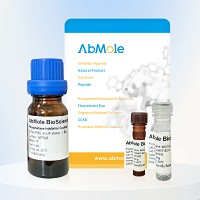All AbMole products are for research use only, cannot be used for human consumption.

Species: Mouse
Expression system: E.coli
Purity: > 95% as determined by reduced SDS-PAGE
Molecular weight: 12.6 KDa
Endotoxin: LAL test measured less than 0.1 ng/µg (1EU/µg)
Storage and stability: The freeze-dried protein should be stored at ≤-20°C for one year after receiving. The recombinant protein solution can be stored at 2-8℃ for 2-7 days. The bisector of the recombinant sample was stable at ≤-20°C for 3 months
Bioactivity: Protein S100-A11(S100A11) is a member of the S-100 family. S100A11 is widely expressed in a variety of tissues, distributed in cytoplasm, nucleus and even peripheral cells. S100A11 exists as a noncovalent homodimer with antiparallel conformation. Binding of Ca(2+) to S100A11 causes conformational changes that expose hydrophobic gaps in S100A11 and facilitate its interaction with target proteins. As a two-cell growth medium, S100A11 acts as both a tumor suppressor and a tumor promoter in many different types of tumors, and plays its respective role in influencing cancer cell proliferation proteins. In the nucleus, S100A11 inhibits keratinocyte growth and induces cell differentiation by activating p21 (CIP1/WAF1). S100A11 is also a new diagnostic marker for breast cancer.
| Solubility (25°C) | It is not recommended to reconstitute to a concentration less than 100μg/ml. |
| Storage |
Powder -20°C 3 years ; 4°C 2 years In solvent -80°C 6 months ; -20°C 1 month |
| Related Cytokines and Growth Factors Products |
|---|
| Recombinant Human GDF-15 Protein (HEK293 N-hFc)
Growth-differentiation factor 15 (GDF15), also known as MIC-1, is a secreted member of the transforming growth factor (TGF)-β superfamily. GDF-15 has a role in regulating inflammatory and apoptotic pathways in injured tissues and during disease processes. GDF-15 overexpression arising from an expanded erythroid compartment contributes to iron overload in thalassemia syndromes by inhibiting hepcidin expression. |
| Recombinant Human FGFR1 Protein (HEK293, C-His)
FGFR1, also known as CD331, is a full-length representative protein consists of an extracellular region, composed of three immunoglobulin-like domains, a single hydrophobic membrane-spanning segment and a cytoplasmic tyrosine kinase domain. |
| Recombinant Human FGFR2 Protein (HEK293, C-His)
FGFR2, also known as CD332, acts as cell-surface receptor for fibroblast growth factors and plays an essential role in the regulation of cell proliferation, differentiation, migration and apoptosis, and in the regulation of embryonic development. FGFR2 plays an essential role in the regulation of osteoblast differentiation, proliferation and apoptosis, and is required for normal skeleton development. It also promotes cell proliferation in keratinocytes and imature osteoblasts, but promotes apoptosis in differentiated osteoblasts. |
| Recombinant Mouse BMP-4 Protein (E. coli, C-His)
Bone Morphogenetic Protein-4 (BMP-4) is a critical signaling molecule required for the early differentiation of the embryo and establishing of a dorsal-ventral axis. BMP-4 is secreted from the dorsal portion of the notochord, and it acts in concert with sonic hedgehog to establish a dorsal-ventral axis for the differentiation of later structures. |
| Recombinant Human Coagulation Factor X (HEK293, C-Fc)
Coagulation factor X, belongs to the peptidase S1 family. Coagulation factor X is initially synthesized in the liver. Coagulation factor X is a vitamin K-dependent glycoprotein that converts prothrombin to thrombin in the presence of factor Va, calcium and phospholipid during blood clotting. |
All AbMole products are for research use only, cannot be used for human consumption or veterinary use. We do not provide products or services to individuals. Please comply with the intended use and do not use AbMole products for any other purpose.


Products are for research use only. Not for human use. We do not sell to patients.
© Copyright 2010-2024 AbMole BioScience. All Rights Reserved.
